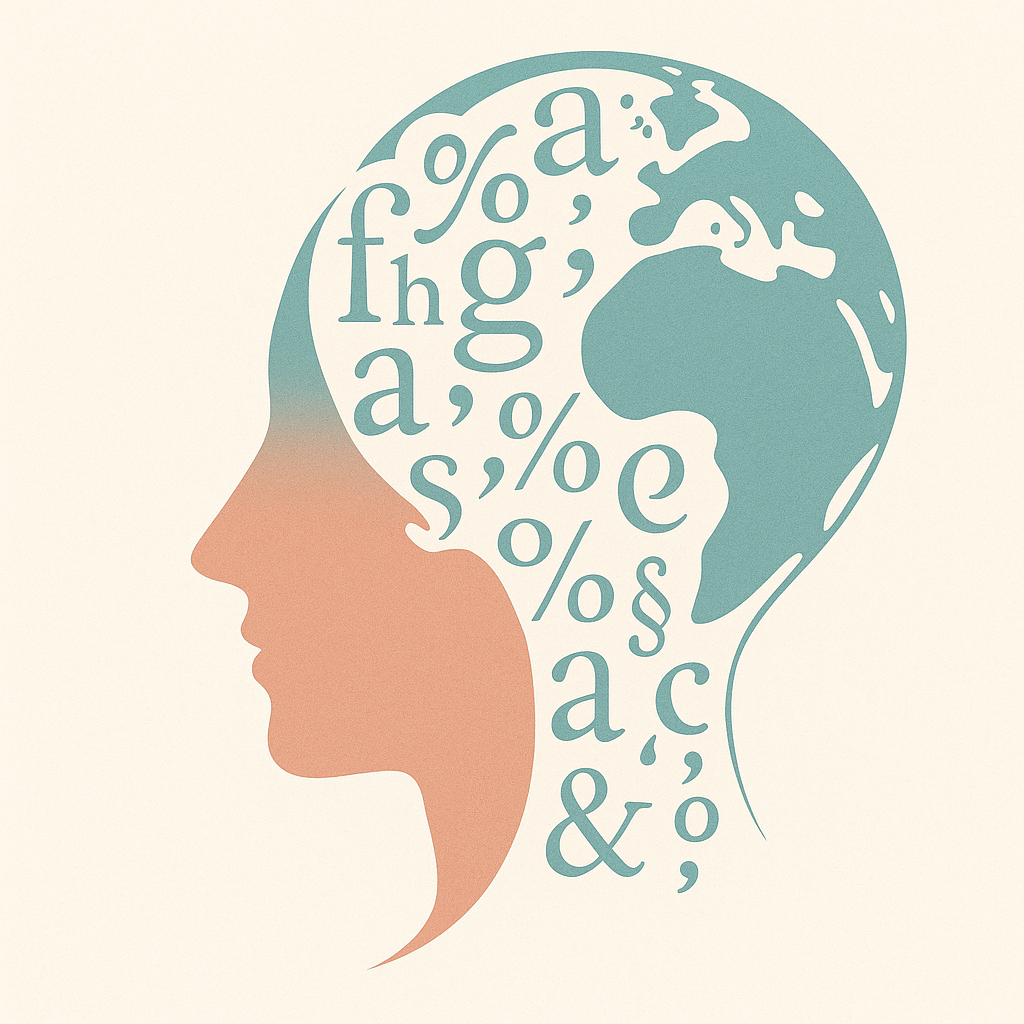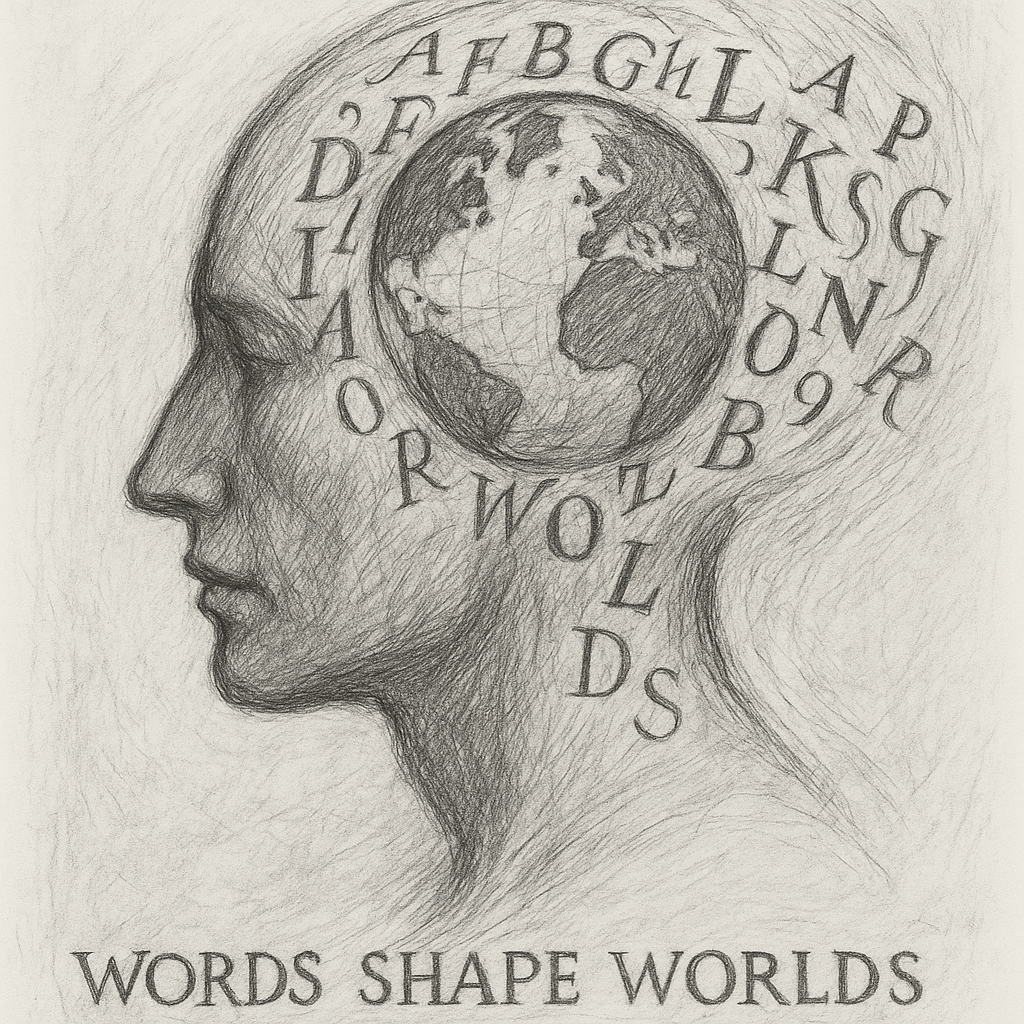Words Shape Minds: How Language Influences Thought

Every day we use language to describe what we see and feel. Yet language isn’t just a passive label for experience – it actively shapes how we think. As cognitive scientists note, “habits in language encourage habits in thought,” so there may be “not a lot of adult thinking where language does not play a role” . Experiments confirm this: even a single word can change what people perceive or remember . As one review puts it, “every message, even the most mundane, is crafted with a specific frame… that impacts how the message is perceived.” In short, our words help give shape to our minds. In this essay we’ll explore evidence from psychology and neuroscience showing how the way we speak – in media, politics, advertising and everyday life – can literally change how we think. We’ll also hear from speakers of different languages, to see how language diversity leads to different worldviews.
Language and Cognition: Scientific Evidence
Researchers have found many concrete ways that language affects perception and memory. For example:
- Spatial frames: Some languages use absolute directions instead of left/right. In the Kuuk Thaayorre language of Australia, people say “north” or “south” even when describing a placement on a table, not “left” or “right” . Speakers of such languages develop an uncanny sense of direction: one study notes they can “keep track of where they are” exceptionally well, better than people living in the same landscape who speak relative-direction languages . In lab tests, when Kuuk speakers arranged picture cards in chronological order, they always laid them east-to-west regardless of orientation (because east-west is forward-back in their language) .
- Time metaphors: Different tongues talk about time differently, and this affects thought. English typically treats time as flowing left-to-right (e.g. we look “ahead” to the future and say we’re “behind” schedule). Mandarin Chinese speakers also use left-right metaphors, but they add vertical metaphors: the past is “up” and the future “down.” In experiments, Mandarin speakers were quicker than English speakers at ordering time-related tasks presented vertically . Even more striking, the Aymara people of the Andes gesture for the past as if it were in front of them (since it’s “known”), and the future behind (since it’s “unseen”) . Thus the linguistic image of time – horizontal vs. vertical, front vs. back – literally changes how people imagine temporal order.
- Causality and memory: The grammar of a language can control how we recall events. English often forces us to name an agent: “He broke the vase.” By contrast, Spanish or Japanese might describe the same event without explicitly blaming anyone (“The vase broke itself”). Experiments show English speakers tend to remember who did something in an accidental scenario better than Japanese or Spanish speakers do . In one study, English speakers described car accidents in agentive terms and later recalled the actor more accurately, whereas Japanese/Spanish speakers (who used passive descriptions) recalled less. In short, when your language habitually makes you cite the actor or omits it, your memory follows suit .
- Perceptual categories: Language provides categories that sharpen perception. For instance, teaching people a new word for a color actually improves their ability to distinguish that color from a near hue . Studies show that giving people extra color labels changes their visual discrimination. Similarly, number words shape number sense: in Mandarin Chinese the words for 11–19 make base-ten structure obvious (e.g. literally “ten-one,” “ten-two”…). As a result, Chinese-speaking children grasp place value sooner than English-speaking children . In general, “changing how people talk changes how they think,” as one review puts it .
- Bilingual shifts: Speaking two languages can even let a person shift perspectives. In one experiment, Arabic–Hebrew bilinguals showed different automatic attitudes depending on the test language: they expressed more positive feelings toward Jews when tested in Hebrew than when tested in Arabic . This suggests that switching tongues can subtly flip one’s frame of mind.
In sum, hundreds of lab studies have found that linguistic habits spill over into general cognition. As Boroditsky and others conclude, “Adults rely on language even when doing simple nonverbal tasks… categories that exist in languages are… meddling in our mental lives very broadly” . In practical terms, this means our everyday words influence perception and memory in very fundamental ways.
Framing the World: Media, Politics, and Advertising
If language shapes thought at a deep level, it’s no surprise that people in media and politics pay careful attention to words. This is the realm of framing effects: changing one or two words can sway public opinion. As one recent review notes, “we routinely use words to try to influence what other people are thinking, feeling, and doing” . Politicians, journalists, and advertisers know this power well.
- Metaphors in media: Consider how journalists talk about issues like disease or finance. A classic study described a story about cancer using two metaphors: one version framed it as a battle (“cancer cells storm the body”), and another as a journey. People who read the “battle” article judged cancer more deadly and urgent than those who read the “journey” article . In other words, the battle metaphor (“fighting cancer”) made people feel more alarmed. As the framing researchers explain, metaphors like “war” leverage familiar scripts (battles, journeys) to shape our beliefs about complex topics .
- Political spin: The same applies to policy language. In immigration debates, terms matter. One study asked Americans about a proposal to legalize immigrants; wording the policy as “amnesty” versus an “opportunity to become citizens” produced wildly different reactions . When described as “amnesty,” opposition was high, but phrasing it as a positive “path to citizenship” virtually eliminated net opposition (a 17-point swing on the survey) . Similarly, labels like “illegal immigrant” vs. “undocumented worker,” or “tax relief” vs. “tax cut,” often trigger very different emotional responses (even though the underlying idea is the same). A journalism guide notes that battles over terms (like “anchor baby” vs. “birthright baby”) reflect real framing power, even if raw public opinion is sometimes less sensitive to each specific word .
- Advertisers’ language: Marketing also weaponizes words. Ads and slogans use vivid language to sell emotions. Marketers routinely deploy metaphors, rhyme, alliteration and emotional adjectives to make brands stick in our minds. Research in consumer psychology confirms these tricks work: for example, product descriptions with rich figurative language (like metaphors or puns) are more persuasive, especially for pleasurable (hedonic) products . One review found that when consumers read reviews or ads with more metaphorical phrasing, they were more drawn to “hedonic” options (like vacation packages) than when the same message was worded plainly . Sound symbolism and sensory words (e.g. “velvety,” “crisp,” “robust”) also tap our associations. In short, advertisers know that the right catchphrase or emotional word can steer our buying choices almost subconsciously.
- Social media and speech: Even in everyday ads or tweets, framing plays a role. Though not always studied in labs, it’s common to see headlines designed to trigger outrage (“You won’t believe what happened…”), to label opponents (“radical,” “socialist”), or to use repetition and memes to frame debates. A recent review of social media content noted that political influencers tend to use more anger- or fear-inducing words, affecting how audiences interpret issues. Similarly, propagandists rely on loaded language and euphemisms (e.g. “collateral damage” for civilian deaths) to manage public opinion. The bottom line: our mental frames are constantly being steered by subtle word choices in the news we read and ads we see.
From these examples we see that small shifts in wording can sway beliefs and emotions. The framing literature concludes that if we understand these effects better, we can improve our communication and resist manipulation . As one framing team puts it, knowing how words work “serves as a reminder to be mindful of both the words and phrases we use [and] the ones that grab our attention or generate a strong emotional response.” In other words, we should pay attention not just to what is said, but how it’s said – because language steers the content of our thoughts.
Personal Life: Rewriting Your Inner Script
Language doesn’t only shape how others think – it shapes our own private world. Psychologists have long noted that putting feelings into words can actually change those feelings. The practice of affect labeling – naming an emotion or writing about a stressful event – has measurable benefits. For example, studies find that writing about a negative experience in one’s journal can improve mood and reduce anxiety . Simply acknowledging “I feel angry” or “I am anxious” dampens the intensity of those emotions in the brain (lowering amygdala response and physiological arousal) . This is why therapists encourage people to describe problems in words and even reframe them with kinder language (“I can’t do this” becomes “I will try my best”). Changing one’s self-talk from negative to positive phrases can boost motivation and reduce stress.
Language also guides our expectations, which then color perception. As Gary Lupyan’s vision experiments showed, hearing “pumpkin” helped people literally see a suppressed picture of a pumpkin . Similarly, he illustrates that if you think your milk is orange juice, the milk may taste “wrong” – because your expectation (set by the name you have in mind) reshapes sensory input . In everyday life this means that our mental labels influence how we experience the world: expecting a pleasant outcome makes us more likely to notice positive details, while framing a challenge as a “learning opportunity” rather than a “failure” changes our emotional reaction to it.
Of course, all this is intuitive to many of us. We know that talking positively to ourselves can help us cope (“I’ve done hard things before”). The new research simply puts numbers on these effects. In fact, an emerging review notes that internal self-talk is a crucial mental activity used for thinking, problem-solving and self-regulation . By deliberately choosing our words, even when speaking silently to ourselves, we can steer our mindset. For example, encouraging self-talk (“Keep going, you’ve got this”) can improve athletic or academic performance, while chastising language (“I always fail”) may undermine confidence. Even quick language shifts in memory help: describing a personal challenge as “my problem” versus “an obstacle” can change feelings of blame.
The key takeaway in personal life is that you can rewire your own thinking by the words you use. Label and think through emotions and experiences carefully: talking or writing about them can provide clarity and calm. As a review in emotion psychology summarizes, putting feelings into words literally sends signals to your brain to tone things down . In short, mindful language use – positive phrasing, accurate labels, thoughtful metaphors – can be a form of mental self-care.
Different Languages, Different Worlds

Finally, it’s illuminating to consider multilingual evidence: speakers of different languages often do perceive the world differently. Linguists have long catalogued striking differences between languages that can lead to different habitual thoughts. For example, as Boroditsky recounts, one language (Mian, spoken in New Guinea) requires verbs to specify when an action happened, whereas Indonesian verbs do not mark tense at all . In Russian, verb forms reveal the speaker’s own gender. Mandarin Chinese forces you to say whether your “uncle” is on your mother’s side or father’s side. Amazingly, the Amazonian Pirahã language has no words for exact numbers – only concepts like “one,” “two,” or “many” . These grammatical quirks reflect cultural differences in focus: a Pirahã speaker living without precise counting treats quantities very differently from someone with 0–9 number words.
Other cross-cultural studies make the point: take pronoun use. Japanese and other pro-drop languages routinely omit pronouns (“Went to store” for “I went to the store”), whereas English always uses “I/you.” Researchers Kashima & Kashima (1998) found that societies whose languages drop personal pronouns tend to be more collectivistic – emphasizing groups over individuals – than societies whose grammar constantly marks “I” and “you” . The hypothesis is that a language habitually omitting the self in speech may reinforce a worldview that downplays the individual.
Even our special descriptive words can differ. English has one word “snow,” but Sami languages in the Arctic famously have dozens of terms for snow and ice types. Whether Inuit really have 50 words for snow is debated, but having more specific terms would sharpen distinctions in perception. Conversely, English has unique coinages like schadenfreude (German) or saudade (Portuguese) for which there is no single English equivalent . For example, Portuguese speakers use saudade to mean a mix of longing, nostalgia and hope after a loved one’s departure – a concept English can only describe in a phrase . One might speculate that speakers of Portuguese literally recognize that complex emotion more readily because their language binds it into one word.
Finally, bilingual brains show cultural switching. People who speak English and another language sometimes report “thinking differently” depending on the language. In fact, some studies find that making decisions or expressing emotions in a second language feels more detached and analytical (partly because emotional words might carry less force in your non-native tongue). One lab experiment found German–English bilinguals were better at regulating negative feelings when they labeled them in English (their L2) than in German , perhaps because the second language creates a bit of emotional distance. In practice, many bilinguals notice that jokes or stories “play out” differently in each language, suggesting our mental frames adjust when we switch tongues.
These multilingual perspectives remind us that language is not just a neutral container for thought. Each language highlights and hides different facets of reality. When we learn a new language, we often report seeing the world in a new light. In this sense, changing the way we express ourselves (even tiny shifts of phrasing) is like giving our minds a new lens: it can open us to new perceptions, memories, and attitudes.
Takeaway: Be Mindful of the Words
By now the evidence is clear: language and thought are deeply intertwined. What we say (and hear) can guide what we see, remember and believe. Words can frame a problem, evoke emotion, or even tune our senses. As researchers of framing conclude, gaining a deeper understanding of this can “enhance our communication skills” and improve outcomes by making us “mindful of both the words and phrases we use” .
In practice, this means paying attention to language – in news, in ads, and in our own heads. Try rephrasing negative thoughts in kinder terms, or examining news stories for the implicit frames they use. When reading or listening, note words like battle, crisis, choice, or undocumented and ask how they shape your gut reaction. Likewise, when speaking or writing, notice how your wording influences the response: are you invoking fear or hope, blame or responsibility?
Language is a powerful tool of the mind. By choosing our words thoughtfully, we can, quite literally, reshape how we think. Scientific studies and real-world examples both show that a small change of phrase can pivot a perspective. Whether we’re campaigning for a cause, selling a product, or simply talking to ourselves, understanding the influence of language helps us communicate more effectively and understand our own minds better.
Sources: Psychological and neuroscience research shows language’s effects on perception and reasoning . Classic cognitive studies document cross-linguistic differences in space, time, memory and emotion . Framing studies in politics and marketing demonstrate how word choice changes opinions . Techniques like affect labeling and reframing have been tested in therapy and brain experiments . These findings confirm that words matter – a lesson well illustrated by the fact that just spelling out “WORDS MATTER” brings the point home【62†】. Each claim above is supported by empirical research as cited.
